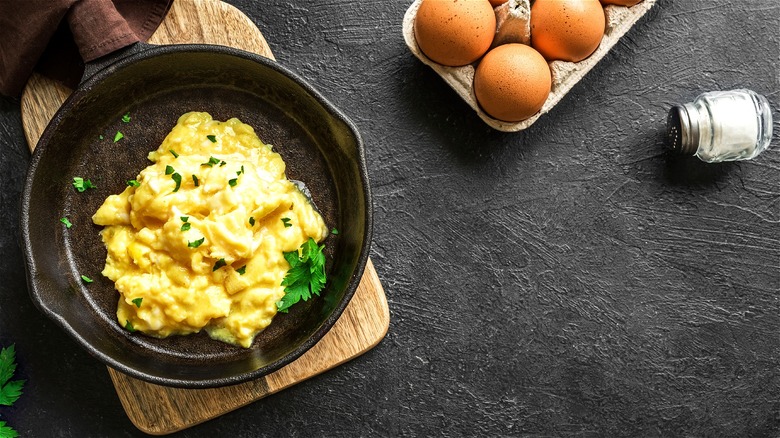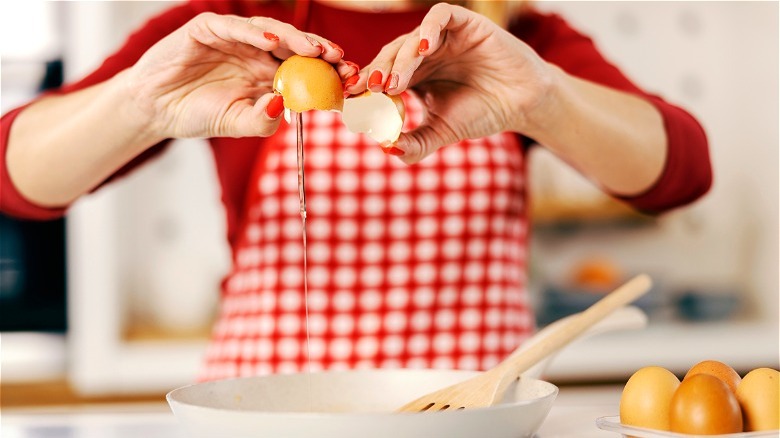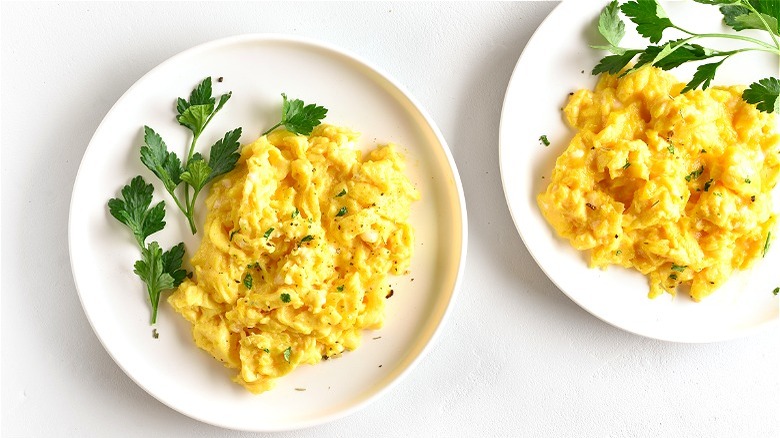Scramble Your Eggs Last Minute For The Fluffiest Results (No Matter How Wrong It Feels)
Making a pan of scrambled eggs seems fairly foolproof, right? You gather your toast, jam, and maybe a few unexpected ingredients that go great with eggs; many of us could probably cook them with our eyes closed. However, when it comes to what ends up on our plates, on the taste and texture scale, we've likely all experienced varying degrees of satisfaction. While 2019 data from YouGovAmerica discovered that 36% of surveyed Americans preferred their morning plates with a side of scrambled eggs over varieties like hard-boiled or fried, how many of us can safely say we know how to cook a mean pan of scrambled eggs?
Even though many of us are used to cracking eggs into a bowl and sloshing them with a fork or whisk before pouring the mixture into a hot pan, as it turns out, waiting to scramble eggs until they begin to set in a hot skillet might be the way to go. While changing old habits can be a good thing, you may find yourself feeling especially uncomfortable as you crack fresh eggs in a frying pan and wait for them to whiten without maneuvering them with your trusted spatula. But what are the details of this ingenious egg scrambling technique and why does it produce the fluffiest results?
The egg scrambling technique you never knew you needed
Sure, simply relying on the basics when cooking scrambled eggs could yield a more relaxed breakfast routine, but now that you're aware of this shocking piece of advice, it's worth getting into the logistics. This innovative cooking technique is a favorite of Caroline Fidanza, the chef and co-owner of Saltie, an erstwhile sandwich shop in Brooklyn, New York. Her creative recipe was added to a compilation of master recipes published by way of Lucky Peach food magazine in a book titled "All About Eggs."
Fidanza explains the intricacies of this technique to Epicurious, detailing how you first melt butter in a skillet and wait for the fat to slightly bubble and for the pan to become hot. You then crack eggs directly into the pan, add a little salt, and leave them alone until the egg whites begin to turn cloudy and partially set. From here, you simply leave the eggs undisturbed for another minute or two then remove the pan from heat and quickly break the yolks with your spatula, swirling the runny yellow insides into the scrambled whites. This leaves your eggs perfectly soft and you don't have to worry about overcooking those tender yolks. However, this way of scrambling eggs isn't the only unique method worth trying.
Additional scrambled egg variations
If cracking eggs directly into a hot pan makes you feel extremely uneasy, you can still change things up by adding an unexpected element to your eggs instead. Out of all the secret ingredients celeb chefs use in their scrambled eggs, beyond potato starch and milk powder, water seems to be a safe choice for many. Producing a guaranteed batch of soft eggs isn't always guaranteed, but a small amount of water added to raw whisked eggs actually turns into steam when heated, which in turn may make your next batch of scrambled eggs extra fluffy. Besides trying water or the classic addition of milk, if you're someone who craves creamy eggs, you may want to mix in a tablespoon of sour cream to your egg mixture before cooking.
If you'd rather not take too many risks in potentially ruining that classic egg flavor, you may want to try cooking scrambled eggs in a different vessel other than your trusted skillet. The Incredible Egg outlines how you can make scrambled eggs in your oven as long as you have a shallow baking pan and a watchful eye to stir your oven eggs at just the right increments. Scrambled eggs are one of those dishes that can be made in a number of different ways. While you can use one of the above suggestions, if soft, fluffy eggs are what you desire most, try cracking eggs directly into your skillet next time and judge the results yourself.


